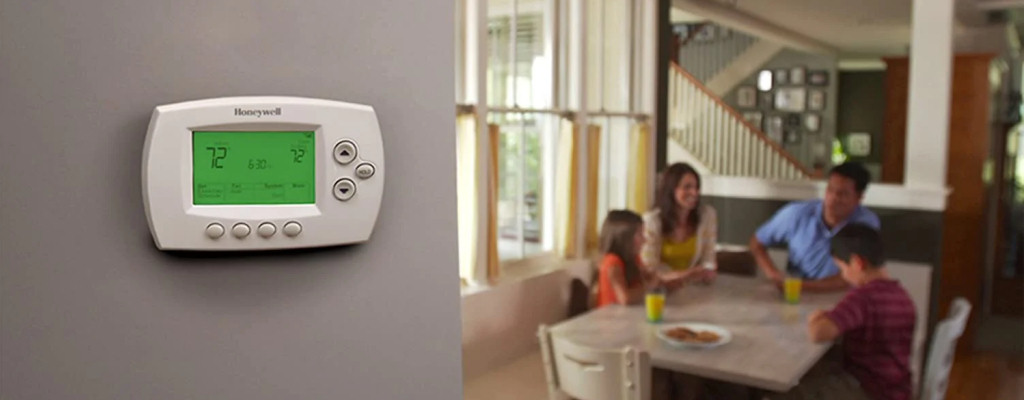You’ve probably heard that a programmable thermostat will lower your heating and cooling bills. While this is undoubtedly true, you won’t instantly save just by swapping out that old manual thermostat model for a programmable one. To maximize your savings, it’s essential to select, set up, and use a programmable thermostat correctly.
The U.S. Department of Energy (DOE) says that homeowners can save up to 10% on their heating and cooling costs by adjusting the temperature between 7-10°F from its usual setting for eight hours every day. For the average home, this means you’ll save up to $180 per year! Follow these handy programmable thermostat tips to save the most on your energy bill.
How to select the right programmable thermostat for your home
As you compare thermostats, a good place to start is to confirm the model’s compatibility with your other HVAC equipment. For example, a heat pump may require a different type of thermostat than one intended for a conventional forced-air system.
Then, examine the unit’s scheduling functionality. Most programmable thermostats have four daily programs, usually labeled as Wake, Leave, Return, and Sleep. In addition, several dynamic levels of control are available. Here are the four primary options:
5-2 programming means you can set one program for weekdays (5) and the weekend (2). This type combines ease of use with the flexibility of split scheduling.
5-1-1 programming lets you set a weekday schedule and one each for Saturday and Sunday. This is a good choice if your routine stays the same Monday through Friday but is different each weekend day.
7-day programming allows a different schedule every day of the week. If your schedule changes nearly every day, or you simply want maximum control over each day’s thermostat settings, this is the type for you.
1-week programming uses one schedule for the entire week. If you’re a retiree or you rarely leave home for any significant amount of time, this model’s ease of use is perfect for your living situation.
Basic programmable thermostat setup
The ability to schedule set periods while you’re away or sleeping makes saving energy with a programmable thermostat simple. A smart way to do this is to decide what settings you want at the beginning of the heating and cooling seasons – that is, twice a year. A little time spent to determine the temperatures and times that work best for your family’s needs will be well-rewarded in comfort and energy savings! Here’s a typical weekday schedule to get you started:
Wake at 6:00 am. The thermostat tells your system to reach a comfortable temperature in time for your morning coffee. The DOE recommends 68°F during the winter and 76°F in the summer.
Leave at 8:30 am. The thermostat adjusts the temperature back 10 degrees when you head to work. This setting should be approximately 64°F in the winter and 80°F in the summer.
Return at 5:30 pm. The thermostat resumes a comfortable temperature when you get home from work. As with the Wake setting above, this setting should be approximately 68°F in the winter and 76°F during the summer.
Sleep at 11:00 pm. The thermostat sets your home’s overnight temperature, so your system runs less often. This setting should be about 64°F in the winter and 80°F during the summer.
How to get maximum savings from a programmable thermostat
While the recommended temperatures above will minimize your HVAC system’s operating time – saving energy usage and saving you money – perhaps the best benefit of a programmable thermostat is that you’ll save money without sacrificing comfort. Try these tips to get the most from your upgrade:
Avoid overriding the programmed settings. While you can always override the current temperature if you’re uncomfortable, your energy bill will go up if you regularly change the settings. Instead, put on an extra layer of clothing in the winter or turn on a fan in the summer before you fiddle with the thermostat.
Use the hold feature correctly. Virtually every programmable thermostat allows a temporary override without deleting the active setting. This is called the Hold feature, which only lasts until the next programmed event. Note that this differs from the “permanent/vacation hold” feature, which is for when you are out of town. It overrides the settings until you return. The thermostat won’t go back to your regularly programmed schedule until you manually clear the hold.
Don’t make extreme temperature changes. When you need to override a setting, it’s wise to change the thermostat by a few degrees at most. You should feel plenty comfortable after making a slight adjustment, and you won’t waste energy by cranking the temperature way up or down.
Change the batteries. Most programmable thermostats use batteries to prevent the settings from being deleted due to a power outage. Replacing your thermostat batteries is a simple task, but one that’s easily forgotten. To jog your memory, set a recurring reminder in your smartphone’s Calendar app once a year, such as the new year or when the kids head back to school in the fall.
We have the answers to all your thermostat questions
If you prefer to set it and forget it – and who doesn’t? – choose Hey Neighbor Heating & Cooling for help selecting and installing a programmable thermostat. We can also provide details about more advanced thermostats, such as “smart” models, which come with even more benefits, such as routine learning capabilities, remote temperature control, motion sensors, energy reports, and more. For additional information or to schedule a visit with one of our friendly Comfort Consultants, contact Hey Neighbor Heating & Cooling today.


Comments are closed